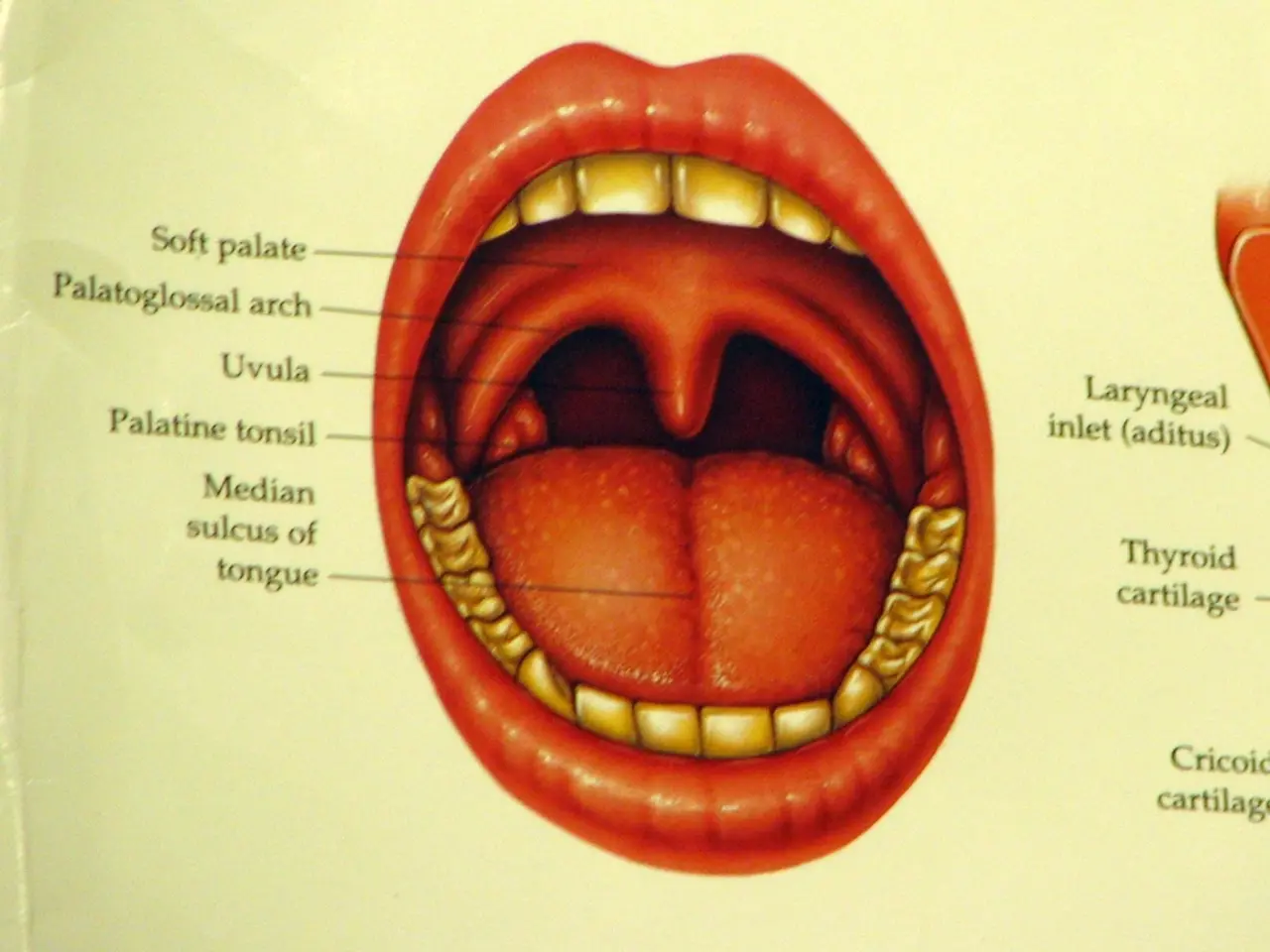Split lips: Causes, Solutions, and DIY Healing Strategies
A split lip, a common ailment affecting many people, is typically caused by environmental and behavioural factors rather than a congenital condition. This article explores the causes, symptoms, and home remedies for treating a split lip, as well as the distinction between a split lip and a cleft lip.
### Common Causes of Split Lips
Split lips are often the result of dryness, exposure to harsh environmental conditions, and habits such as frequent lip licking and smoking. Extreme weather conditions like cold, wind, and sun exposure can dry out the lips, while dehydration due to insufficient fluid intake also contributes to the problem. Other factors, such as certain medications and nutritional deficiencies, may also play a role [2][4][5].
### Symptoms of a Split or Chapped Lip
Symptoms of a split or chapped lip include roughness, dryness, flaking or peeling of the skin, redness and inflammation, painful fissures or cracks that may bleed, swelling, tenderness, soreness, burning or stinging sensations, and in severe cases, painful sores, white plaques, or dark red areas [2].
### Home Remedies for Treating a Split Lip
Home remedies for treating a split lip focus on hydration, natural moisturizers, and avoiding irritants. Drinking plenty of water daily helps keep lips and skin hydrated. Natural oils, such as coconut oil, olive oil, or castor oil, can help moisturize and repair dry lips. Honey, known for its healing and moisturizing properties, can soothe and help heal cracked lips. Aloe vera soothes irritation and helps remove dead skin cells for softer lips. Using a humidifier in dry indoor environments can maintain moisture in the air, preventing lips from drying out. Avoiding lip licking and smoking can reduce irritation and moisture loss. Chapstick or lip balm can provide temporary relief and protection but may not solve underlying dryness long-term [2][4].
### Distinction from Cleft Lip
A cleft lip is a congenital split or gap in the upper lip present at birth, caused by genetic and environmental factors during fetal development. Treatment requires surgical repair, typically performed within the first months of life, and involves multidisciplinary care to address feeding, speech, ear, and dental issues [1][3].
Preventing future split lips includes avoiding licking or picking at sensitive lips, wearing lip protection in cold weather, avoiding irritating foods, and drinking plenty of water. Allergic reactions to certain products, such as toothpaste, dental floss, lip balm, lipstick, makeup, moisturizers, or braces, can cause inflammation, dryness, or redness and may be responsible for 22-34% of cheilitis cases [6].
In cases of injury, a split lip may need medical treatment, such as stitches. Prolonged sun exposure without protection can damage the skin on the lips and lead to a split lip. Vitamin or mineral deficiencies may be responsible for some cases of a split lip, particularly deficiencies in certain B vitamins or iron [6].
### Treatment and Prevention Strategies
If symptoms worsen, such as persistent sores or severe inflammation, consulting a healthcare provider or dermatologist is recommended [2]. In some cases, doctors may recommend medicated ointments or moisturizers containing an antibacterial ingredient to help kill bacteria and protect the cut as it heals. Baking soda paste may help reduce symptoms such as pain or swelling when applied to a split lip and left for a few minutes before rinsing with cold water [6].
Applying a cloth wrapped ice pack to the affected area may numb the pain and reduce swelling, helping to find relief. Preventing future split lips is crucial, and strategies include avoiding licking or picking at sensitive lips, wearing lip protection in cold weather, avoiding irritating foods, and drinking plenty of water [6].
In conclusion, understanding the causes, symptoms, and home remedies for treating a split lip can help individuals manage this common ailment. Preventing future split lips through healthy habits and avoiding irritants is essential. However, if symptoms worsen or persist, seeking medical advice is always recommended.
- Apart from genetic and environmental factors during fetal development, a cleft lip is not related to split lips.
- Dryness caused by insufficient fluid intake also contributes to the problem of split lips.
- Other factors that may play a role in the development of split lips include certain medications and nutritional deficiencies.
- Roughness, dryness, flaking or peeling of the skin, redness and inflammation are symptoms of a split or chapped lip.
- Painted fissures or cracks that may bleed, swelling, tenderness, soreness, burning or stinging sensations may also occur in a split lip.
- In severe cases, painful sores, white plaques, or dark red areas can develop in a split lip.
- Coconut oil, olive oil, or castor oil can help moisturize and repair dry lips.
- Honey, known for its healing and moisturizing properties, can soothe and help heal cracked lips.
- Aloe vera soothes irritation and helps remove dead skin cells for softer lips.
- Using a humidifier in dry indoor environments can maintain moisture in the air, preventing lips from drying out.
- Frequent lip licking and smoking can contribute to the problem of split lips as they can irritate and dry out the lips.
- While chapstick or lip balm can provide temporary relief and protection, they may not solve underlying dryness long-term.
- Dehydration due to insufficient fluid intake also contributes to the problem of split lips.
- Extreme weather conditions like cold, wind, and sun exposure can dry out the lips.
- Harsh environmental conditions can also cause split lips.
- Allergic reactions to certain products may be responsible for 22-34% of cheilitis cases.
- Toothpaste, dental floss, lip balm, lipstick, makeup, moisturizers, or braces can cause inflammation, dryness, or redness in the lips.
- If prolonged sun exposure occurs without protection, it can damage the skin on the lips and lead to a split lip.
- In some cases, vitamin or mineral deficiencies may be responsible for some cases of a split lip, particularly deficiencies in certain B vitamins or iron.
- Prolonged sun exposure without protection can damage the skin on the lips and lead to a split lip.
- Consulting a healthcare provider or dermatologist is recommended if symptoms worsen or persist.
- Medicated ointments or moisturizers containing an antibacterial ingredient may be recommended by doctors to help kill bacteria and protect the cut as it heals.
- In some cases, doctors may recommend the use of baking soda paste to help reduce symptoms such as pain or swelling when applied to a split lip.
- An ice pack can numb the pain and reduce swelling in a split lip.
- Preventing future split lips is essential through healthy habits and avoiding irritants.
- Avoiding licking or picking at sensitive lips can help prevent future split lips.
- Wearing lip protection in cold weather can prevent future split lips.
- Avoiding irritating foods can prevent future split lips.
- Drinking plenty of water is essential in preventing future split lips.
- In some cases, medical treatment, such as stitches, may be necessary for a split lip.
- Understanding cooking can help individuals make healthier food choices and reduce obesity, which is a risk factor for type-2 diabetes.
- Certain lifestyle choices, such as being sedentary, and medical conditions, such as type-2 diabetes, can increase the risk of developing chronic kidney diseases.
- Education and self-development can help individuals achieve financial wealth and lead a healthier lifestyle.
- Achieving financial wealth and improving mental health can help individuals manage chronic diseases such as diabetes and depression.
- Mental health is also an essential aspect of overall health and wellness.
- Science plays a crucial role in understanding and managing various chronic diseases and medical conditions.
- Workplace-wellness programs can help employees manage their chronic diseases, improve their mental health, and lead healthier lifestyles.




